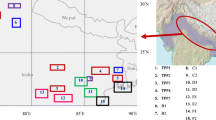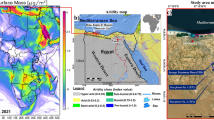Abstract
NO2 is a reactive gas which is produced mainly due to man-made activities (burning of fossil fuels) and influences negatively people organisms and environment. Since the Earth population keeps increasing, the content of the gas in the atmosphere is expected to rise. Satellite monitoring is the most optimal method to observe the spatio-temporal distribution of NO2 in the troposphere globally which cannot be achieved by ground-based measurements. However, there are several different satellite measurement systems which provide the information on tropospheric NO2. In the current study we compared tropospheric NO2 data for the more than 10-year period retrieved from the measurements of OMI and GOME/SCIAMACHY/GOME-2 satellite measurement systems for the territories of Saint Petersburg and Leningrad region (Russia). Also, we investigated correlation between the NO2 tropospheric content by satellite measurements and near-surface NO2 concentration by ground-based measurements in Saint Petersburg. The research demonstrated that OMI and GOME/SCIAMACHY/GOME-2 data on tropospheric NO2 content possessed large discrepancies (approximately 100% relative to OMI data) for the area and period of interest. The datasets did not correlate well but some similarities in a seasonal variation of the tropospheric NO2 content for Saint Petersburg and Leningrad region were found. In addition, we registered an obvious correlation in the trend of near-surface and tropospheric NO2 content obtained by ground-based and OMI satellite measurements respectively.






Similar content being viewed by others
REFERENCES
J. Wallace and P. Hobbs, Atmospheric Science: An Introductory Survey (Academic Press, Canada, 2006).
World Health Organization. “9 out of 10 people worldwide breathe polluted air, but more countries are taking action.” https://www.who.int/news/item/02-05-2018-9-out-of-10-people-worldwide-breathe-polluted-air-but-more-countries-are-taking-action. Accessed June 23, 2021.
J. Seinfield and S. Pandis, Atmospheric Chemistry and Physics (Wiley-Interscience, 2006).
S. Tronin, A. Kritsuk, and A. Kiselev, “Estimation of multiyear changes in nitrogen oxide concentrations over Russia from satellite measurements,” Sovrem. Probl. Distantsionnogo Zondirovaniya Zemli Kosmosa 16 (2), 259–265 (2019). https://doi.org/10.21046/2070-7401-2019-16-2-259-265
World Health Organization, Air Quality Guidelines, Second Edition, 2000. https://www.euro.who.int/__ data/assets/pdf_file/0017/123083/AQG2ndEd_7_1nitrogendioxide.pdf. Accessed June 23, 2021.
B. Sportisse, Fundamentals in Air Pollution (Springer, Dordrecht, 2010).
P. J. Crutzen, “The role of NO and NO2 in the chemistry of the troposphere and stratosphere,” Annu. Rev. Earth Planet. Sci. 7, 443–472. (1979).
A. Tronin, S. Kritsuk, and I. Latypov, “Satellite Observations of Nitrogen Dioxide in Russia,” Sovrem. Probl. Distantsionnogo Zondirovaniya Zemli Kosmosa 6 (2), 217–223 (2009).
Federal State Statistics Service, Russian regions, socio-economic indicators, 2011. http://www.gks.ru/bgd/ regl/b11_14p/IssWWW.exe/Stg/d01/05-17.htm. Accessed June 23, 21.
Administration of the Baltic Sea ports. https://www. pasp.ru/arhiv. Accessed June 23, 2021.
European Environment Agency, Explaining Road Transport Emissions: A Non-Technical Guide (Publications Office of the European Union, Luxembourg, 2016).
D. L. Goldberg, L. N. Lamsal, C. P. Loughner, W. H. Swartz, Z. Lu, and D. G. Streets, “A high-resolution and observationally constrained OMI NO2 satellite retrieval,” Atmos. Chem. Phys. 17, 11403–11421 (2017). https://doi.org/10.5194/acp-17-11403-2017
Y. M. Timofeyev, I. A. Berezin, Y. A. Virolainen, M. V. Makarova, A. V. Polyakov, A. V. Poberovsky, N. N. Filippov, and S. Ch. Foka, “Spatial–Temporal CO2 variations near St. Petersburg based on satellite and ground-based measurements,” Izv., Atmos. Ocean. Phys. 55 (1), 59–64 (2019). https://doi.org/10.1134/S0001433819010109
Y. Timofeyev, Y. Virolainen, M. Makarova, A. Poberovsky, D. Ionov, S. Osipov, and H. Imhasin, “Ground-based spectroscopic measurements of atmospheric gas composition near Saint Petersburg (Russia),” J. Mol. Spectrosc. 323, 2–14 (2016). https://doi.org/10.1016/j.jms.2015.12.007
J. Gu, L. Chen, C. Yu, S. Li, J. Tao, M. Fan, X. Xiong, Z. Wang, H. Shang, and L. Su, “Ground-level NO2 concentrations over China inferred from the satellite OMI and CMAQ model simulations,” Remote Sens. 9 (6), 519 (2017). https://doi.org/10.3390/rs9060519
Royal Netherlands Meteorological Institute, Ozone Monitoring Instrument (OMI). https://www.knmiprojects.nl/projects/ozone-monitoring-instrument. Accessed June 23, 2021.
H. Bovensmann, J. P. Burrows, M. Buchwitz, J. Frerick, S. Noel, V. V. Rozanov, K. V. Chance, and A. P. H. Goede, “SCIAMACHY: Mission objectives and measurement modes,” J. Atmos. Sci. 56 (2), 127–150 (1998). https://doi.org/10.1175/1520-0469(1999)056%3C0127:SMOAMM%3E2.0.CO;2
University of Bremen, SCIAMACHY homepage. https://www.iup.uni-bremen.de/sciamachy. Accessed June 23, 2021.
European Space Agency, SCIAMACHY. https://earth. esa.int/web/guest/missions/esa-operational-eo-missions/ envisat/instruments/sciamachy. Accessed June 23, 2021.
European Space Agency, Envisat. https://www.esa.int/ Enabling_Support/Operations/Envisat. Accessed June 23, 2021.
J. P. Burrows, M. Weber, M. Buchwitz, V. Rozanov, A. Ladstätter-Weißenmayer, A. Richter, R. DeBeek, R. Hoogen, K. Bramstedt, K. Eichmann, M. Eisinger, and D. Perner, “The Global Ozone Monitoring Experiment (GOME): Mission concept and first scientific results,” J. Atmos. Sci. 56 (2), 151–175 (1998). https://doi.org/10.1175/1520-0469(1999)056<0151:TGOMEG>2.0.CO;2
European Space Agency, About GOME-2. http:// www.esa.int/Applications/Observing_the_Earth/Meteorological_missions/MetOp/About_GOME-2. Accessed June 23, 2021.
EUMETSAT, GOME-2. https://www.eumetsat.int/ gome-2. Accessed June 23, 2021.
J. Callies, E. Corpaccioli, M. Eisinger, A. Hahne, and A. Lefebvre, “GOME-2: Metop’s second-generation sensor for operational ozone monitoring,” Eur. Space Agency Bull. 100, 28–36 (2000).
Homepage Julien Chimot: a journey in Earth observation satellite science. TROPOspheric Monitoring Instrument (TROPOMI). https://julien-chimot-research. blog/tropospheric-monitoring-instrument-tropomi/. Accessed June 23, 2021.
European Space Agency, Instrumental Payload. https://sentinels.copernicus.eu/web/sentinel/missions/ sentinel-5p/instrumental-payload. Accessed June 23, 2021.
C. Lee, R. V. Martin, A. van Donkelaar, A. Richter, J. P. Burrows, and Y. J. Kim, “Remote sensing of tropospheric trace gases (NO2 and SO2) from SCIAMACHY,” in Atmospheric and Biological Environmental Monitoring, Ed. by Y. J. Kim, U. Platt, M. B. Gu, and H. Iwahashi (Springer, Dordrecht, 2009), pp. 63–72.
K. F. Boersma, D. J. Jacob, H. J. Eskes, R. W. Pinder, J. Wang, and R. J. van der A, “Intercomparison of SCIAMACHY and OMI tropospheric NO2 columns: Observing the diurnal evolution of chemistry and emissions from space,” J. Geophys. Res. 113, D16S26 (2008). https://doi.org/10.1029/2007JD008816
M. J. Bechle, D. B. Millet, and J. D. Marshall, “Remote sensing of exposure to NO2: Satellite versus ground-based measurement in a large urban area,” Atmos. Environ. 69, 345–353 (2013). https://doi.org/10.1016/j.atmosenv.2012.11.046
K. F. Boersma, R. Braak, and R. J. van der A, Dutch OMI NO2 (DOMINO) data product v2.0 HE5 data file user manual. https://d37onar3vnbj2y.cloudfront.net/ static/docs/OMI_NO2_HE5_2.0_2011.pdf. Accessed June 23, 2021.
R. J. van der A and H. J. Eskes, Product Specification Document Tropospheric NO2. https://d37onar3vnbj2y.cloudfront.net/static/docs/PSD_NO2.pdf. Accessed June 23, 2021.
Report on Environmental Conditions in St. Petersburg for 2018, Ed. by I. A. Serebritskii (St. Petersburg, 2019) [in Russian]. https://www.gov.spb.ru/static/writable/ckeditor/uploads/2019/08/12/42/doklad_za_2018_EKOLOGIA2019.pdf. Accessed June 23, 2021.
Author information
Authors and Affiliations
Corresponding author
Rights and permissions
About this article
Cite this article
Sedeeva, M., Tronin, A., Nerobelov, G. et al. Variation of Tropospheric NO2 on the Territories of Saint Petersburg and Leningrad Region According to Remote Sensing Data. Izv. Atmos. Ocean. Phys. 57, 669–679 (2021). https://doi.org/10.1134/S0001433821200032
Received:
Revised:
Accepted:
Published:
Issue Date:
DOI: https://doi.org/10.1134/S0001433821200032




